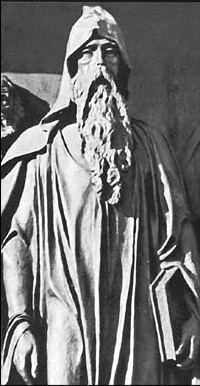There were always political intrigues surrounding that office [bishop of Constantinople], for the patriarchate of Constantinople had become a point of discord between the patriarchs of Antioch and Alexandria…most of the patriarchs of Constantinople were Antiochenes, and therefore the patriarchs of Alexandria regarded them as their enemies…For these reasons, Nestorius’ position was not secure, and the Alexandrines were looking to catch him at his first mistake.
 Once Nestorius began challenging the declaration that Mary is the Mother of God the Alexandrines found reason to pursue his dismissal. The ensuing “debate” over Nestorius’ positions is something that sounds like political scandal of the 21st century. You can read about it here.
Once Nestorius began challenging the declaration that Mary is the Mother of God the Alexandrines found reason to pursue his dismissal. The ensuing “debate” over Nestorius’ positions is something that sounds like political scandal of the 21st century. You can read about it here. So, what do we make of Nestorius’ actual position. Should we accept the Mother of God syllogism? Is Mary the Mother of God? Does Christ have “two natures” in "two persons"? Did Nestorius even believe that Christ had two natures in two person?
Personally, I see Nestorius’ point. I am not sure I would be willing to be lynched for it, but I see his point. But if we say that Mary is not the Mother of God then do we have to divide Christ into two natures in two persons? Nestorius is saying that she is the mother of his humanity but not to his divinity. Does this then make Christ have two natures in two persons? I am not convinced that was what Nestorius called for (at least in the way it sounds). At the end of the day I think Nestorius makes a valid point but he was not overly clear in doing so.
What can we learn from this? Again, I offer two points of application.
1) If you plan on tipping over a sacred cow make sure you are willing for it to crush you.
By the time Nestorius came on the scene the term Theotokos (mother/bearer of God) had became a standard for orthodoxy. It was a simple way of affirming the deity of Christ. Perhaps this should not have been the sign of orthodoxy. Maybe, it was not even the best way of outlining the deity of Christ. But was everything Nestorius went through worth fighting this phrase? Certainly, he though it was. The lesson for us is to consider whether we are willing to be crushed by the sacred cow we are trying to tip over. Some need tipped over and we need courageous men and women to start pushing immediately. Occasionally, we need to just wait it out through faithful biblical teaching.
2) It is always easier to critique than it is to create.
Nestorius probably would not have gotten in nearly as much trouble if he had only questioned the use of the Theotokos and left it at suggesting a few alternatives. But he pushed harder and tried to better explain how Christ deity and humanity resided in the same person. This got Him in trouble. It is always easier to critique something than to create something better in its place. This does not mean that things cannot be questioned, nor does it mean that we never create. This is simply a warning to say before you critique something attempt to create a better alternative—but beware to be critiqued yourself (or possibly burned at the stake).
Nice! Very nice! LOL
ReplyDeleteVery fair treatment and I enjoyed the truth given with a touch of humor.